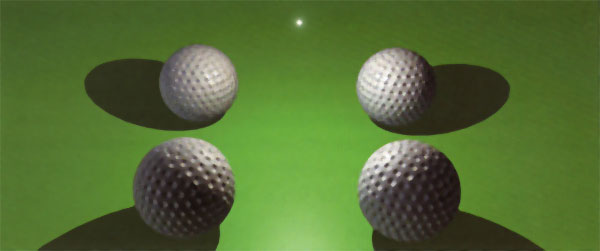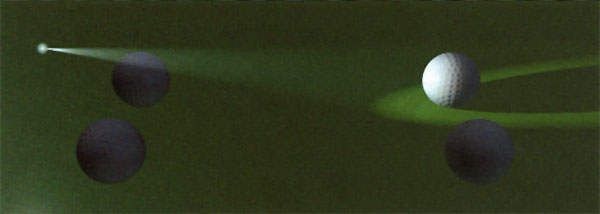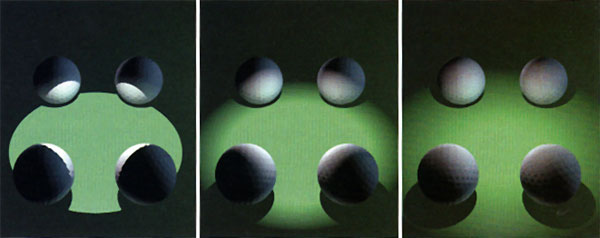Types of Lights in Maya
Point Lights

A point light simulates rays shining out from one infinitely small point in space.
Point lights emit light uniformly in all directions, like a bare light bulb or glowing star in space. The illumination and shadows aim out away from the light in all directions, as shown in the following figure:

A point source emits light evenly in all directions.
In real life, you aren't likely to find any light that is uniformly omnidirectional. Most sources emit more light in some directions than others. If you are adding point lights to your scene to simulate real light bulbs, for example, remember that most real light bulbs have an opaque metal socket that blocks light from one end, and many are mounted in some kind of fixture or shade that limits their directionality.
Even though point lights start out as omnidirectional, you can give them a throw-pattern that is uneven, like a real light bulb, to aim more light in some directions than in other directions. You can do this by applying a texture map to the light, or by grouping the light with 3D objects that will cast shadows.
Spot Lights

Spot lights are a basic staple of most lighting designs in computer graphics. Spot lights are a popular choice of many artists because they can be controlled conveniently to aim light at a specific target, as shown in the following figure:

A spot light can aim light at a specific target.
A spot light simulates light radiating from a point, much like a point light. A spot light, however, limits the illumination to light within a specified cone or beam of light only. The rotation of a spot light can determine where the beam is aimed. You can also link a "target" to the light so that the light is always oriented toward the position of the target. You can also group a spot light with a 3D object, such as a model flashlight or car headlight assembly, so that the beam of light will be aimed as if the light were radiating from the object.
Spot lights are staples of visual effects in your renderings. A spot light has extra controls and options not found on other types of lights. Options such as projecting an image map from a light, or making a beam of light visible as if shining through fog, are often best controlled with the beam of a spot light.
Other common spot light parameters enable you to control the width of the cone (usually specified in degrees) to vary between a narrow beam and a broad one. The amount of Dropoff of the cone allows the intensity of the light to diminish more gradually as it approaches the edge of the beam. A softer edge on a spot light's beam will make the light's individual location less obvious and will avoid creating a harsh "circle" of projected light, as shown if the leftmost image here:

A spot light cone's softness can be adjusted with the dropoff.
This enables you to more subtly lighten or darken areas with a spot light. With a very soft-edged beam, for example, you can aim a spot light from within a room to brighten the general area around a window and curtains, or aim a spot light with a negative brightness at the corner of a room to darken it.
Because spot lights can be aimed and controlled so conveniently, some artists rely on them to simulate light from almost any source and light most of their scenes entirely with spot lights. Even when a light needs to shine in multiple directions, such as the light from a table lamp, two or more spot lights can be positioned together and aimed in different directions.
Directional Lights

A directional light sets a single vector for all its illumination and hits every object from the same angle, no matter where the object is located. All the shadows cast by a directional light are cast in the same direction and are orthogonal projections of each object's shape.
It does not matter where a directional light is located relative to the objects being lit. The only thing that matters in placing a directional light is which way it is pointed. The angle used by a directional light is controlled by the rotation manipulator.
Because a directional light is not as easy to aim or confine to a local area as a point light or spot light, it is most useful as a part of your secondary or fill lighting, and not as the main light on a subject. A set of directional lights from different angles can be used together to provide fill light, even if the individual lights from each angle are very dim. Directional lights can fill very large areas with illumination that appears to be ambient or atmospheric, such as filling in daylight from the sky, providing a quick, effective alternative to global ambience.
Area Lights

In Maya, area lights are two-dimensional rectangular light sources. Use area lights to simulate the rectangular reflections of windows on surfaces. Compared to other light sources, area lights can take longer to render, but they can produce higher quality light and shadows. Area lights are particularly good for high-quality still images, but less advantageous for longer animations where rendering speed is crucial.
Volume Lights

A major advantage of using a volume light is that you have a visual representation of the extent of the light (the space within which it is bound). The falloff of light in the volume can be represented by the color ramp (gradient) attribute in Maya, which prevents the need for various decay parameters, and also provides additional control. The color gradient is also useful for volume fog.
You can achieve different effects with light direction. Outward behaves like a point light and Downward acts like a directional light. Inward reverses the light direction for shading, giving the appearance of inward illumination. When using shadows with Inward light direction you may get unexpected results. In all cases the light shape dictates the extent of the light.
Use a volume light to illuminate within a given space. Volume lights provide control of light direction, color and decay within a bounded volume.
Ambient Lights

In real life, ambient light is the widely distributed, "indirect" light that has bounced off (or been transmitted through) objects in your scene. Ambient light illuminates even the areas not directly lit by another light source. Shadowed areas of a real room are sometimes made visible only by the ambient light. Real-life ambient light is tinted as it bounces around the environment and adds different colors to different sides of objects, based on colors it has picked up from the environment. Real ambient light varies in intensity in different parts of the environment and adds different tones to objects from different angles.
However, in Maya, the ambient light just adds the same color and intensity to all sides of an object, without regard for its position.
In general, an ambient light will rob your scene of richness and variety, especially in areas not illuminated by other light sources. To get the most control over your lighting, and the best quality of shading, do not use any ambient lights!